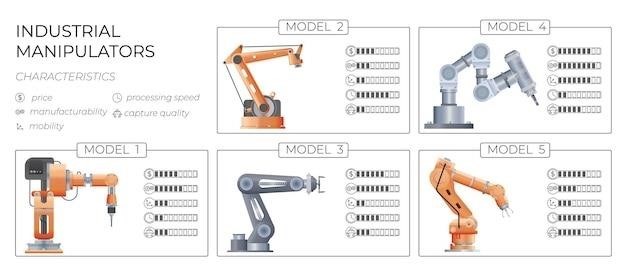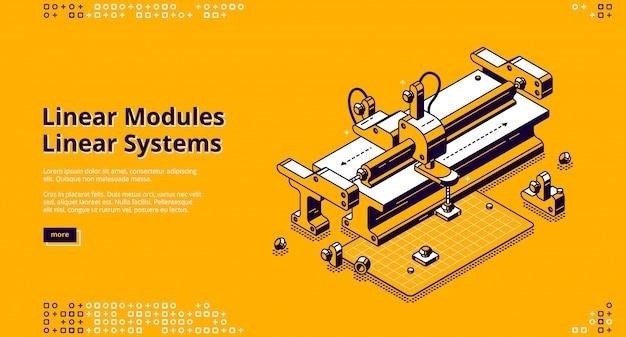Yaskawa V1000 Technical Manual⁚ Key Information
This comprehensive manual covers the Yaskawa V1000 Compact Vector Control Drive․ It details installation‚ wiring‚ operational procedures‚ troubleshooting‚ maintenance‚ and safety precautions․ Multiple model variations and power ratings are specified․ Downloadable PDF versions are available․
Installation Procedures
The Yaskawa V1000 installation process begins with careful review of the provided technical manual․ Mechanical installation involves securely mounting the drive to a stable surface‚ ensuring adequate ventilation and clearance for heat dissipation․ Pay close attention to the weight and dimensions of the specific V1000 model to select appropriate mounting hardware and location․ Proper grounding is crucial for safety and optimal performance; follow the grounding instructions precisely․ Before proceeding with electrical connections‚ verify that the power supply matches the drive’s specifications․ Incorrect voltage or phase can damage the unit․ The electrical installation requires connecting the power supply‚ motor‚ and control signals according to the wiring diagrams in the manual․ Use appropriately sized and rated wires and connectors․ Double-check all connections before powering on the unit․ After completing the electrical connections‚ carefully inspect for any loose wires or potential hazards․ Once the installation is finished‚ a thorough inspection is necessary to ensure that all connections are secure‚ and the unit is properly grounded and ventilated․ This meticulous approach guarantees safe and efficient operation․
Wiring Diagrams and Connections
The Yaskawa V1000 technical manual provides detailed wiring diagrams crucial for proper installation and operation․ These diagrams illustrate the connections between the drive‚ motor‚ and control devices․ Understanding these diagrams is essential to avoid damage to the equipment and ensure safe operation․ The diagrams show the connections for power supply‚ motor terminals‚ control signals (such as start/stop commands‚ speed references‚ and feedback signals)‚ and any optional modules․ Pay close attention to the color-coding of wires and terminal designations․ The manual specifies the appropriate wire gauges and connector types to use for each connection․ Using incorrect wiring can lead to malfunction‚ overheating‚ or even equipment failure․ Before making any connections‚ carefully review the relevant sections of the manual to understand the purpose of each wire and terminal․ Take extra care to avoid short circuits or incorrect polarity․ Always ensure that the power supply is disconnected before making any wiring changes․ After completing the wiring‚ carefully check all connections to ensure they are secure and correctly made․ Refer to the troubleshooting section of the manual if any issues arise during or after the wiring process․ Always refer to the latest version of the manual for the most accurate and up-to-date wiring diagrams․
Operational Procedures and Parameter Settings
The Yaskawa V1000 technical manual provides comprehensive instructions on operational procedures and parameter settings․ Understanding these procedures is critical for safe and efficient operation of the drive․ The manual outlines the steps involved in starting‚ stopping‚ and controlling the motor speed and torque․ It details how to adjust various parameters to optimize the drive’s performance for specific applications․ These parameters control aspects such as acceleration/deceleration rates‚ speed regulation‚ and various protection features․ The manual explains each parameter’s function and its impact on the drive’s behavior․ It also provides guidance on selecting appropriate parameter settings based on the motor’s characteristics and the application requirements․ Modifying parameters incorrectly can lead to unexpected behavior or damage to the equipment․ The manual recommends using the factory default settings as a starting point and making adjustments carefully and incrementally․ It’s crucial to record the original parameter settings before making any changes․ The manual may also include information on using programming tools or software for more advanced parameter adjustments․ Always refer to the specific sections of the manual related to parameter settings and operational procedures for your particular V1000 model and configuration․ Remember‚ safe and efficient operation hinges on a thorough understanding of these procedures and settings․

Troubleshooting and Maintenance
This section details common Yaskawa V1000 errors‚ solutions‚ and preventative maintenance schedules․ Regular inspection and adherence to maintenance procedures are crucial for optimal performance and longevity․
Common Errors and Solutions
The Yaskawa V1000 technical manual provides a detailed troubleshooting section to assist in resolving operational issues․ Common errors encountered with the V1000 drive often involve communication faults‚ parameter misconfigurations‚ or hardware malfunctions․ The manual systematically guides users through a diagnostic process‚ starting with visual inspections of wiring connections and terminal blocks‚ checking for loose or damaged components․ It then directs users to verify power supply stability and the integrity of input signals․ Specific error codes are listed‚ each with a corresponding explanation and suggested corrective actions․ These actions range from simple parameter adjustments through the drive’s programming interface to more complex procedures involving component replacement or professional service intervention․ For instance‚ an overcurrent fault might indicate a motor overload‚ requiring adjustments to the drive’s current limits or investigation of the motor itself․ Communication errors could involve faulty network cabling or incorrect settings within the drive’s communication parameters․ The manual emphasizes the importance of safety and recommends that only qualified personnel attempt repairs or adjustments to the internal components of the drive to prevent electrical shock or injury․ Always refer to the specific error codes displayed on the drive’s interface to pinpoint the exact problem and follow the recommended steps within the manual․ Consult the complete technical manual for exhaustive details and diagrams․
Maintenance Schedules and Procedures
The Yaskawa V1000 technical manual outlines a preventative maintenance schedule to ensure optimal performance and longevity․ This schedule typically involves regular inspections of the drive’s external components‚ including checking for loose connections‚ signs of overheating‚ or any physical damage․ Internal inspections are generally not recommended unless performed by qualified personnel‚ due to the risk of electrical hazards․ The manual details the recommended frequency of these inspections‚ typically based on operating hours or time intervals․ Cleaning procedures are specified‚ focusing on removing dust and debris buildup from cooling fins and other external areas․ The manual might also recommend specific cleaning agents and procedures to avoid damaging the drive’s components․ In addition to visual inspections‚ the manual may suggest periodic checks of operational parameters‚ such as input voltage‚ output current‚ and temperature readings‚ to identify potential issues early on․ These checks can be performed using the drive’s built-in monitoring capabilities or external diagnostic tools․ The manual emphasizes the importance of following the manufacturer’s recommendations for lubrication and replacement of any consumable parts‚ if applicable․ Detailed instructions and diagrams are provided for each maintenance task‚ ensuring proper procedures are followed․ Finally‚ the manual stresses the importance of keeping accurate records of all maintenance activities‚ including dates‚ procedures performed‚ and any findings or corrective actions taken․ Proper maintenance practices significantly extend the operational life of the V1000 drive and minimize the risk of unexpected failures․
Safety Precautions and Warnings
The Yaskawa V1000 manual emphasizes safety․ Always disconnect power before servicing․ Qualified personnel only should perform installation and maintenance․ Heed all warnings and instructions within the manual to prevent injury or damage․
General Safety Guidelines
Before commencing any work on the Yaskawa V1000 drive‚ always ensure that the power supply is completely disconnected․ This crucial step prevents electrical shocks and potential injury․ Never attempt to bypass safety features or modify the drive’s internal components without proper authorization and training․ Always adhere to all local electrical codes and regulations during installation and maintenance․ Improper handling can lead to malfunction‚ fire‚ or serious injury․
Wear appropriate personal protective equipment (PPE) at all times‚ including safety glasses‚ gloves‚ and insulated tools․ Proper grounding is essential to prevent electrical hazards; ensure the drive is correctly grounded according to the instructions in the manual․ Regularly inspect the drive for any signs of damage or wear; replace any damaged parts immediately․ Never operate the drive if you suspect any malfunction; contact qualified personnel for assistance․
Thoroughly understand the operating procedures before starting the Yaskawa V1000․ Always follow the instructions provided in this manual to ensure safe and efficient operation․ Familiarize yourself with the emergency shutdown procedures in case of unexpected events․ Proper training and understanding of safety protocols are paramount for preventing accidents and ensuring the longevity of the equipment․
Specific Safety Instructions for V1000
The Yaskawa V1000 drive incorporates several safety features; however‚ understanding and following specific operational guidelines is crucial for safe operation․ Never touch any live electrical components while the drive is powered․ Before accessing internal components‚ always disconnect the power supply and allow sufficient time for the capacitors to discharge completely․ Failure to do so can result in severe electric shock․
Pay close attention to the warning labels affixed to the drive and follow the instructions provided․ The V1000 may generate high temperatures during operation; avoid contact with the heat sink or other potentially hot surfaces․ Regularly check the cooling fan for proper operation; ensure adequate ventilation to prevent overheating․ Malfunction due to overheating can cause damage to the drive and potentially lead to fire;
When working with the V1000‚ always use the correct tools and techniques․ Improper handling can damage the equipment or cause personal injury․ Refer to the provided diagrams and instructions for proper wiring and connections․ Incorrect wiring could lead to malfunction or even hazardous situations․ If uncertain about any procedure‚ consult the technical manual or contact qualified personnel for assistance․ Prioritize safety at all times․

Specifications and Technical Data
This section details model variations‚ power ratings (0․1kW to 132kW)‚ voltage classes (200V and 400V)‚ and other key technical specifications for the Yaskawa V1000 drive; Consult the full manual for comprehensive data;
Model Variations and Power Ratings
The Yaskawa V1000 AC drive boasts a versatile range of models designed to cater to diverse industrial applications․ These variations are primarily categorized by input voltage and power capacity‚ ensuring compatibility with a wide spectrum of machinery and power systems․ The available voltage classes include 200V and 400V‚ accommodating various global electrical standards․ Within each voltage class‚ multiple power ratings are offered‚ spanning from fractional horsepower units suitable for smaller equipment to higher-power models capable of driving substantial industrial machinery․ This comprehensive range of power ratings‚ typically expressed in kilowatts (kW) or horsepower (HP)‚ ensures that a suitably sized V1000 drive is available for virtually any application‚ from delicate precision systems to robust industrial processes․ Specific model numbers and their corresponding power ratings are detailed in the comprehensive technical specifications section of this manual․ Careful consideration of your specific power requirements and voltage supply is crucial when selecting the appropriate V1000 model for optimal performance and efficiency․ Refer to the detailed specifications table for a complete listing of available models and their respective power capabilities‚ ensuring seamless integration into your industrial automation system․
Detailed Technical Specifications
This section provides comprehensive technical specifications for the Yaskawa V1000 series AC drives․ Detailed information includes precise input voltage ranges for both 200V and 400V classes‚ encompassing three-phase and single-phase configurations․ Output current ratings are meticulously specified for each model‚ ensuring accurate current capacity assessments for your application․ The operational frequency range‚ crucial for controlling motor speed and performance‚ is clearly stated‚ along with details on the supported modulation techniques․ Environmental operating conditions‚ including temperature and humidity tolerances‚ are thoroughly documented to ensure proper installation and sustained operational reliability․ Furthermore‚ the physical dimensions and weight of each V1000 model are provided‚ facilitating accurate space planning and logistical considerations․ Safety certifications and compliance standards are listed‚ confirming the drive’s adherence to relevant safety regulations․ Detailed information on communication protocols‚ such as CC-Link‚ is also provided‚ enabling seamless integration into various industrial automation networks․ Finally‚ thermal protection characteristics‚ including overload capacity and thermal shutdown thresholds‚ are meticulously documented to guarantee safe and reliable operation under demanding conditions․ This complete technical data ensures informed decision-making and precise system integration․
